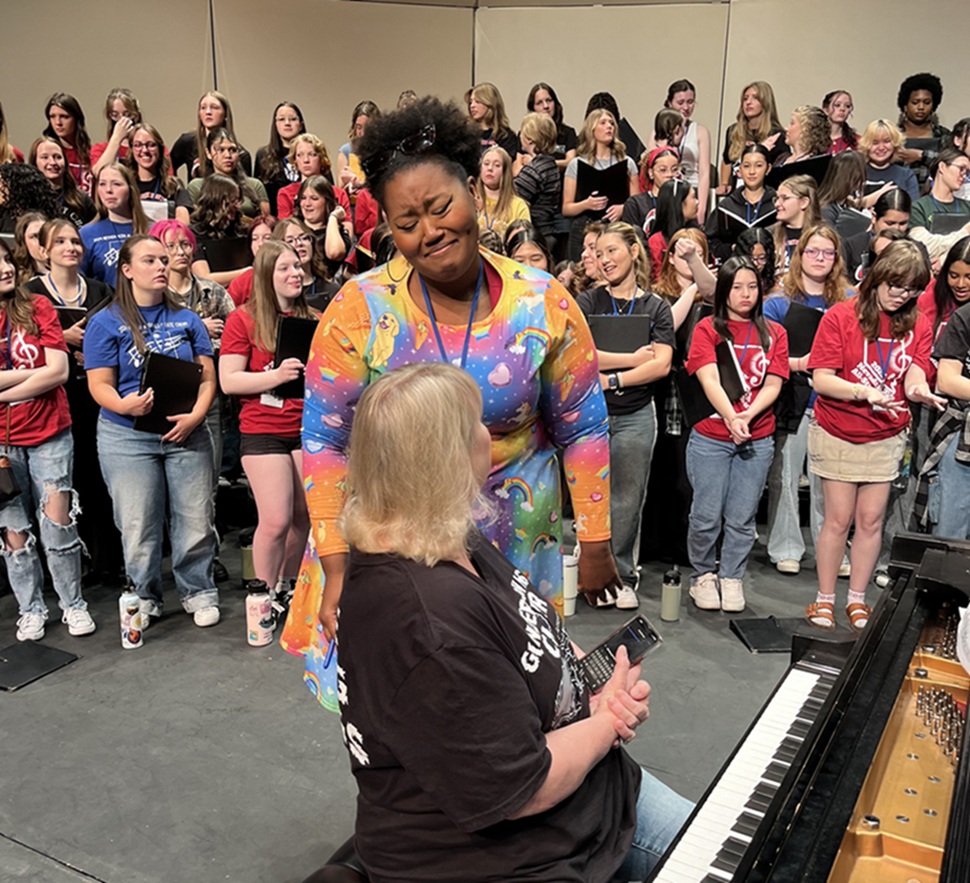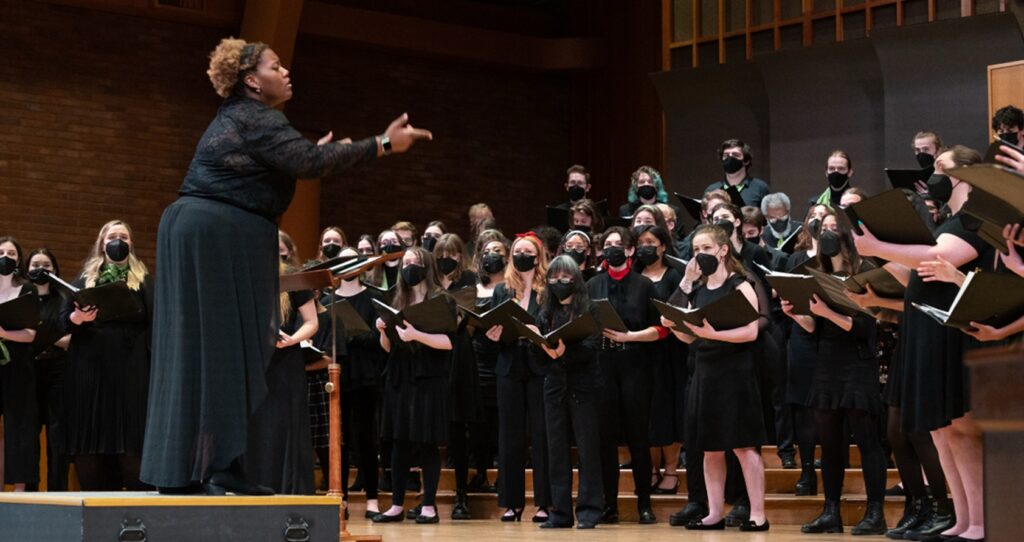Tagged Under:
Case Study: How Popular Music Education Transformed a Texas Program and School
At St. Michael’s Catholic Academy, a forward-thinking curriculum reshaped the music program.
When I started at St. Michael’s Catholic Academy in Austin, Texas, about 10 years ago, I was faced with two challenges: low student program participation and school size.
My vision for revamping and growing the music program centered on finding solutions to both, beginning with student recruitment.
Thinking Outside the Box: Recruitment and Retention
At the beginning of my tenure, less than six students were in the music program. The first step I took was to identify extracurricular music students and invite them and their friends to join the program, not only as musicians, but in a variety of associated roles. Today, approximately 25% to 30% of the student body — or 115 students — participate.
I was able to recruit over 20 students to join that first year. Basically, my approach was to identify that one student who could help. I also targeted freshmen and sophomores because I wanted them to becomae the long-term backbone of the program. I identified a “friend group” and convinced them to join as freshmen. Most of the students in this initial class had little to no experience with music, but they were all excited to be in a class with their friends. That first year focused on coming up with fun ways for them to enjoy music class together.
From there, the next step was to make joining the music program fun and interesting for all students. As a small school, we were not equipped to compete in the usual marching band or orchestral arenas. Being in Austin, Texas, we were minutes away from large schools with successful marching bands the size of our entire student body. Most of our students played guitar, piano and strings — not brass, woodwinds and percussion, so we just didn’t have the instrumentation to go the marching band route.
By this time, I had already developed an affinity for the “popular music education” movement and wanted to explore that approach to make studying music more attractive and relatable to prospective students.
During the first year, I focused on student retention, and I reached out to students individually to find out what they didn’t like at their previous school that deterred them from joining music class at St. Michael’s. Most of their answers revolved around “it wasn’t fun” or “we didn’t play music that I liked.” Coming from a traditional music education background myself, I knew exactly how to build and maintain a competitive marching band or orchestra program, but it was clear that my students were not enthusiastic. Many wanted to learn guitar or piano so they could play with their friends in social settings. They also wanted to play music that they listened to on a regular basis. I decided to start a beginner guitar and drum set class the following year hoping that would pique student interest, which it did.
I was encouraged by St. Michael’s administration to think outside the box, so I began to envision a program unlike any other in Austin. School administrators gave me the green light to move forward because they saw this new program concept as an opportunity to offer something truly unique that was not available at other area private or public schools. Luckily, our investment needs were not extensive, and we gradually accumulated materials, ancillary staffing, equipment and software over time.
I had a limited budget at the onset and purchased a simple drum set and two amplifiers to go along with a basic PA system that was already at the school.
Football Game Performances
In Texas, high school football games are community events. Clearly, I needed an alternative solution to a marching band to get the same community buy-in for St. Michael’s. The answer: A drumline with all of our music students that would perform in the stands during the game. Initially, it was a volunteer student spirit group that eventually became completely led and run by students.
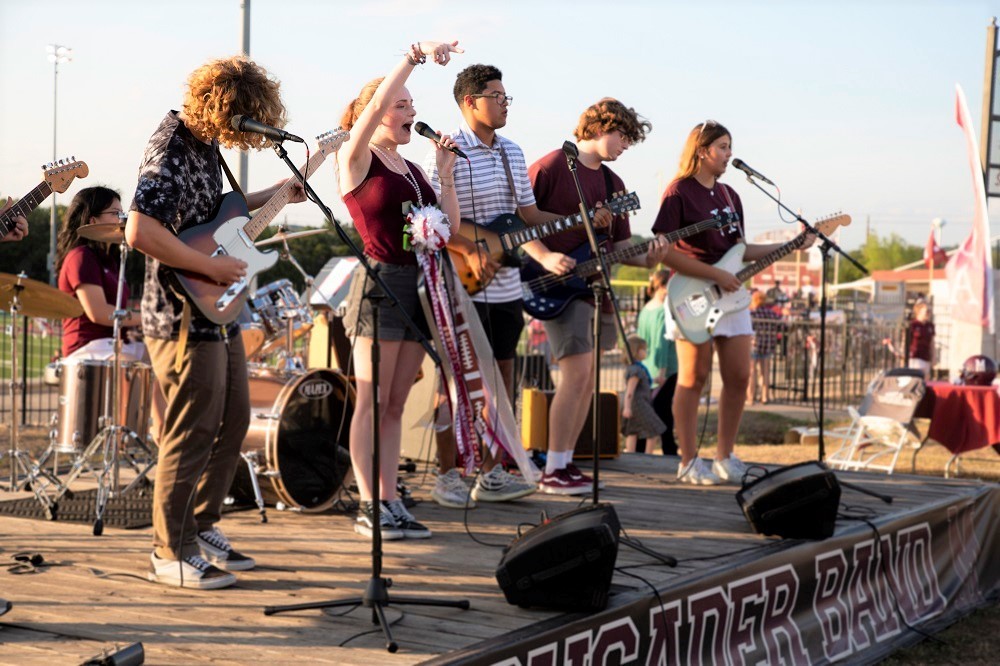 To address the halftime entertainment dilemma, I went with a Super Bowl™-style halftime show that featured our rock bands. This effort entailed procuring custom-made equipment carts to mobilize all the gear. The following year, we started performing at halftime with our rock/country/pop bands. Because the program was steadily growing, and the students were so excited to perform, we also built a wooden stage outside the stadium for tailgate concerts before the games. Today our football game atmosphere reflects a school-wide festival with pregame concerts, barbecues as well as cheerleader and dance team performances.
To address the halftime entertainment dilemma, I went with a Super Bowl™-style halftime show that featured our rock bands. This effort entailed procuring custom-made equipment carts to mobilize all the gear. The following year, we started performing at halftime with our rock/country/pop bands. Because the program was steadily growing, and the students were so excited to perform, we also built a wooden stage outside the stadium for tailgate concerts before the games. Today our football game atmosphere reflects a school-wide festival with pregame concerts, barbecues as well as cheerleader and dance team performances.
We were able to purchase all the gear, equipment and supplies necessary to do this for under $10,000, which is a fraction of what it would have cost to start a marching band program.
Growth and Creating Curriculum
By the third year it was clear that our program was very different, and I embraced this new direction wholeheartedly. Participation went from 4, 24 to 50+ in the first three years, and it kept steadily growing. At the end of the fourth year, I had my first graduating class of musicians, most of whom comprised the group of 20 students I convinced to join the program as freshmen.
The biggest challenge for maintaining the program was finding the curriculum, which was virtually nonexistent. So, I began to create my own. I had operated a music entertainment company in Austin for several years and worked with and hired professional musicians, so I made a list of the attributes that I liked in the musicians I would hire. I spoke with countless musicians and asked them, “What do you wish you had learned in music class when you were in high school?” With that inventory of knowledge, I developed a curriculum to teach those skills, which led me to the idea of creating a non-profit organization called Modern Band Lab, whose goal is to help provide a place for educators to go to find resources and materials for transforming their music classrooms.
During my journey I discovered other educators and organizations who held similar views that music education did not have to exist only in the traditional band/choir/orchestra world.
How It Works
Integration: The popular music education approach is applied not only across all the different music bands — Varsity Symphony, Crusader Bands, Praise Band, Drumline — but it is also integrated with other fine arts programs, such as film, dance and visual arts.
The Varsity Symphony fuses elements of popular music and technology. Crusader Bands (or CruBands) perform at home football games (including the pregame tailgate), pep rallies and other school functions. Their halftime shows are done in collaboration with the drill team and cheerleaders, who excite the crowd with choreographed routines. Chapel services feature the Praise Band, and students in the Tech Crew use professional sound equipment to enhance musical performances of all the bands.
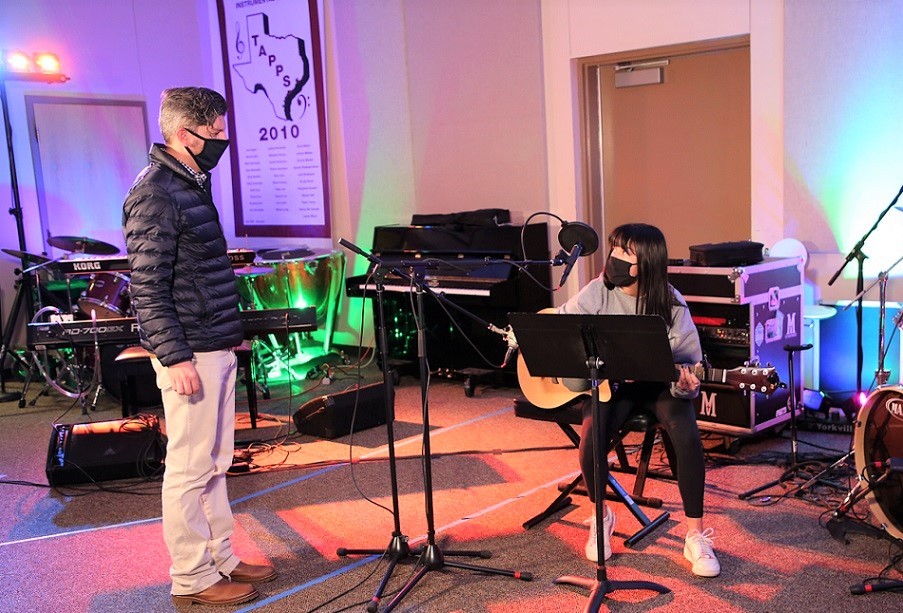
The overarching goal is to help students become comfortable being around technology and equipment that they will likely encounter outside of the classroom and to encourage experimentation. All components are wired up and connected to a computer so that students can instantly record any idea they happen upon during rehearsal. Every student in our program knows how to set up, operate and break down a basic PA system with microphones, in addition to knowing how to hook up their instrument to a laptop.
Posters of legendary artists and album artwork cover the walls to help inspire the students. There is an upright piano in the entrance of the room to encourage students to come in and start playing. Inexpensive LED wall lights are placed around the room to give a cool vibe so that the music room is the coolest place on campus, which makes students visit more often; in doing so, they almost always find time to play or practice, further instilling the lifelong passion for music.
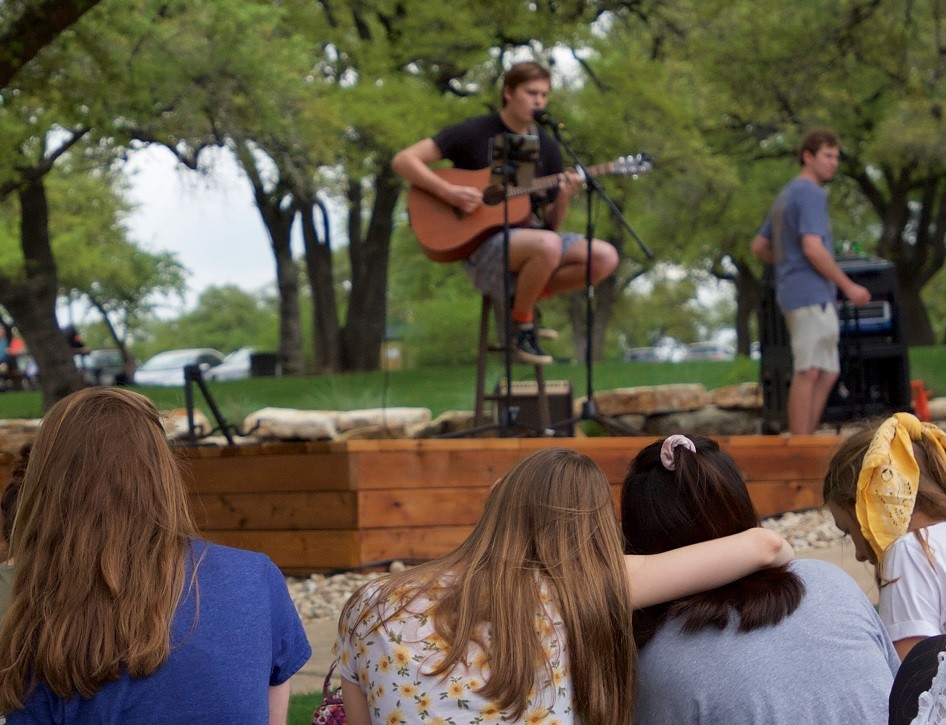 Music students also host “Music-On-The-Deck,” an open-mic performance on the outdoor stage during lunchtime on Fridays during which anyone on campus may perform. Students bring blankets and picnic while listening to their peers play and sing.
Music students also host “Music-On-The-Deck,” an open-mic performance on the outdoor stage during lunchtime on Fridays during which anyone on campus may perform. Students bring blankets and picnic while listening to their peers play and sing.
Leadership: Our vibrant and active Music Leadership Team comprises between 10 to 15 students each year. Students who are interested go through an interview process with me and then are elected by their peers. These student leaders help plan, organize and host on-campus concerts using project-management skills and creativity. They also play an integral role in our halftime performances.
St. Michael’s is blessed to have strong parental support, and we benefit greatly from their involvement in performances and donations of all kinds. We even have a dad band, and our dads play a huge part in our pregame tailgate activities by barbecuing and helping set up the grounds for each football game. Several of them began playing music with their kids on stage, which eventually led to assembling a band of their own.
Cross-Collaboration: Collaboration is key within the music program and among the other fine arts programs.
We began collaborating with our film department by creating one music video a year. Film and music students work together in creating the overall appearance and storyline of the music video. Students may recreate a famous video or produce an entirely original creation, sometimes showing how music can be a catalyst for significant social change and progress.
In cooperation with our dance department, bands play music for dance choreography routines. If halftime band performances call for backup dancers, then they would join forces. Our visual art students help design posters and album covers for our student bands in addition to providing an art gallery reception at all performances. In addition, theater department students help with lights and emcee duties for shows.
Modern Band Lab
A popular outgrowth of our music program was the creation of the Modern Band Lab. The lab involves nine student bands, and one of its more ambitious goals is to create a student-run record label. Students learn how to take an idea from conception and work all the way through to distribution.
I developed an entire Modern Band Lab curriculum, for which St. Michael’s is the flagship school. The course curriculum itself has become part of a nonprofit company, which is also called Modern Band Lab, as a resource for other schools that are interested in starting Popular Music Education and Modern Band Lab at their schools.
Additionally, we’ve cultivated an environment where students are hungry to create and record. In our intense January three-week “Record Your Own Song” class, students learn the entire process of collaborating, recording and producing a song with other students. They are exposed to everything from tracking, editing, mixing, mastering and publishing (or sharing their music with others). Their music is then posted to our SoundCloud account, and recently, our more experienced students have posted their music on Spotify and Apple Music.
Teaching During the Pandemic
We successfully adapted our music program to distance learning at the beginning of the pandemic (we received coverage from the Associated Press and local NBC affiliate KXAN) because students were already using online and collaborative tools. I engage with students on Discussions (in Blackboard) where I ask questions and students post their answers for everyone to see. Students send me videos of themselves performing, and I usually post these on Fridays. I discuss lessons and answer questions during Zoom classes, and I often upload lessons on YouTube. In Google Classroom, weekly assignments are broken down into different tracks based on students’ interests or instruments. Many of these assignments require student collaboration, so even though they aren’t physically in a classroom, students work together. Examples of weekly assignments include:
- guided listening (where students listen to an album with commentary from me telling them what to listen for)
- music technology (students use online music tools like Soundtrap)
- drums (students learn some famous drumbeats and record themselves playing along with a track)
- fingerpicking on acoustic guitar
- creating a music podcast
You can get an inside glimpse into our program in this video.
Looking to the Future
Future plans for St. Michael’s music program include developing the nonprofit Modern Band Lab company to bring this option to schools that may fall within the same framework as our own. I also plan to shoot some specialty videos as resources, such as setting up a music room and showcasing the music recording class while we work to formally launch the student-run record label.
The overarching goal is to cultivate students as lifelong music consumers and patrons, regardless of whether they ultimately choose music for college or career. I like to think the proof of our success is that I regularly get photos and videos from St. Michael’s alumni showing them enjoying music in many different settings — whether it’s a family gathering, a gig or releasing an album. That’s the lifelong music patron we strive to encourage. Of course, we have students getting into top-tier music schools, such as Belmont University, Berklee School of Music and Eastman School of Music, or majoring in music technology and music business. We have received many accolades from students and parents about the impact the St. Michael’s music program has had on their lives and education.
We will continue to think outside the box and look for further opportunities to promote the arts in our students’ lives in and out of the classroom.











